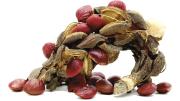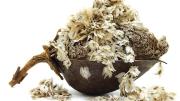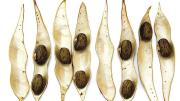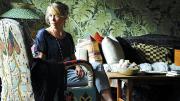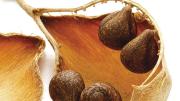In his 2001 book The Botany of Desire, Michael Pollan declared that the existential dilemma of a plant is its immobility. “It can’t pursue a mate, or a seed-dispersal agent, to reproduce,” says Anna Laurent Malsberger ’00. “It can’t flee from a predator or care for its offspring. Plants have had to develop defense mechanisms and ways of interacting with the environment, and other species, to survive.”
The seedpod, or fruit (such as a peach, for example, which both protects the seed and aids in its dispersal), is a crucial reproductive mechanism for many plants. Laurent (her professional surname; www.annalaurent.com) has collected hundreds of these during the past four years. In October, Dispersal, an exhibition of 33 of her breathtaking close-up photographs of seedpods, opened at Arnold Arboretum, one of her collection sites. Her Dispersal project includes written profiles of the fruits with reference to their parent plants (four black seeds encapsulated in the Hawaiian wood rose’s golden pod, for example), and may well become a book. “The seed develops in a fertilized ovary and the seedpod protects the seeds as they mature,” she explains. “The other main function of the seedpod is dispersing the seeds, ideally as far away as possible.”
Laurent’s images, at the intersection of art and science, are beautiful examples of nature photography that also document the fascinating variety of ways plants—particularly the flowering plants called angiosperms, which enclose their seeds in coverings—have evolved to spread genetic material via wind, water, animals, or simply by catapulting it away. “Seedpods are these amazing little packages of DNA,” she says, “but often they are overlooked. People see them as the death of the flowers, but in fact they are the opposite: the future of the species.”
Plants have evolved sophisticated techniques of seed dispersal. “A burdock or a burr will attach itself to any and all passersby,” Laurent said at the exhibit’s opening. “Certain pines are serotinous fire-followers, which means they require heat to trigger seed release. Poppies, on the other hand, need only a gentle tap to disperse hundreds of tiny black seeds, like a pepper pot.” Some plants are very particular about their dispersal agents. The ancient Ginkgo biloba, a gymnosperm, produces unenclosed seeds that some say smell like carrion, probably because it evolved alongside China’s carnivorous civet monkeys. Toyon, a California evergreen shrub of the rose family, produces green berries that are toxic while maturing, discouraging predator consumption, but turn red and benign when mature. “Birds are more sensitive to wavelengths at the red end of the spectrum,” Laurent explains, “so a plant with red seeds often has them dispersed by birds. When the toyon seed turns red, the plant wants the bird to eat it. It’s all about timing. There’s a reason why things look the way they do, and behave they way they do.”
Laurent has collected seedpods not only at the Arboretum (she grew up 15 minutes away in Jamaica Plain), but also in partnership with the Hawaii Tropical Botanical Garden (on the Big Island, Hawaii), Lotusland (a botanic garden in Santa Barbara, California), the Queens Botanical Garden (in New York City), and elsewhere. She has even gathered them in Iraq, as a producer and photographer on The Iraqi Seed Project, a documentary, now in postproduction, on the future of agriculture in the Fertile Crescent. She began collecting in earnest when she moved to Los Angeles in 2008. “Due in part to its unique ecology—including desert, Mediterranean, and riparian climates—and its relative proximity to Asia, Hawaii, and Australia, the botanic diversity in Southern California is unlike anywhere else in the United States,” she says. “In Los Angeles, it became clear that we cohabit closely with a staggering diversity of botanic species. I realized that each plant has a story—how the seed of the individual found itself in that spot, and ultimately, how the plant evolved into a species.”
Science B-29, “Human Behavioral Biology,” helped trigger her botanical passions. The course, nicknamed “Sex” by undergraduates (see “ ‘Sex’ Without DeVore,” January-February 2001, page 75), included Sexual Encounters of the Floral Kind, a documentary Laurent calls “my favorite film of all time.” The history and literature concentrator worked as an interactive designer at Boston’s WGBH-TV on the Nova and American Experience programs, and was a producer and writer with documentary filmmaker Lauren Greenfield ’87 in Los Angeles (see “The Queen of Versailles,” November-December 2012, page 12). Later, she served as a contributing editor at Garden Design magazine, creating and writing the Art and Botany and Botanic Notables columns. The Dispersal project began as a column in Print magazine. Her mission, she says, is “making plants relevant—using plants to connect people across disparate geographies and time periods.”
Laurent treats her seedpod photographs like portraiture, shooting them with a six-point lighting setup inside a light tent. “Each specimen needs a different lighting scenario,” she says, and she may need to choose her model from 50 specimens collected from the same plant; she makes only one final picture per species. “I try not to personify them too much,” she explains, “but if you spend enough time with anything, it will take on a personality.” The photographic process can take hours, but “when I get the angle right, I know it.”
Love for the plants surely helps. “I don’t notice a movie star walking by,” she says, describing her West Hollywood neighborhood. “But I will cross the street to smell a night-blooming jasmine or see a bougainvillea.”
 ">https://www.youtube.com/watch?v=7IZGNF2WJsM]
